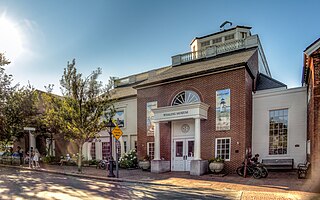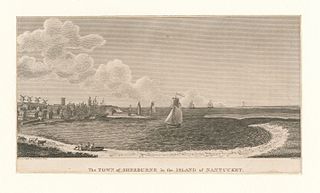
Nantucket is an island about 30 miles (48 km) south from Cape Cod. Together with the small islands of Tuckernuck and Muskeget, it constitutes the Town and County of Nantucket, a combined county/town government in the state of Massachusetts, USA. Nantucket is the southeasternmost town in both Massachusetts and the New England region. The name "Nantucket" is adapted from similar Algonquian names for the island.

Mayhew Folger was an American whaler who captained the sealing ship Topaz that rediscovered the Pitcairn Islands in 1808, whilst one of HMS Bounty's mutineers was still living.
Peleg Coffin Jr. was an American financier, insurer, and politician from Nantucket and Boston, Massachusetts.

Coffin is an English and French surname.
Gideon Gardner was a U.S. Representative from Massachusetts.

Some members of the colonial Coffin family were whalers, agents, merchants, and traders who were prominent during the triangular trade in the United States and Canada. Coffin ship owners, captains, masters, and crew men operated triangle and bilateral trade ships out of Nantucket, Massachusetts, US eastern seaports, and Canadian seaports from the 17th to 19th centuries.

The Oldest House on Sunset Hill, also known as the Jethro Coffin House, was built in 1686 and is believed to be the oldest residence on Nantucket still on its original site. The island's English population at the time totaled several hundred, and the native Wampanoag outnumbered them by at least three to one.
The Starbuck family were prominent in the history of whaling in the United States, based in Nantucket, Massachusetts, from the seventeenth to the nineteenth centuries. Some members of the family gained wider exposure due to their discovery of various islands in the Pacific Ocean.
The Gardner family were a group of whalers operating out of Nantucket, Massachusetts, from the 17th to 19th centuries. Some members of the family gained wider exposure due to their discovery of various islands in the Pacific Ocean. By marriage, they were related to the Coffins, another Nantucket whaling family.
Peter Folger or Foulger was a poet and an interpreter of the American Indian language for the first settlers of Nantucket. He was instrumental in the colonization of Nantucket Island in the Massachusetts colony. He was the maternal grandfather of Benjamin Franklin.

The Nantucket Whaling Museum is a museum located in Nantucket, Massachusetts, United States. It is run by the Nantucket Historical Association. The Whaling Museum is the flagship site of the Nantucket Historical Association’s fleet of properties.

Elizabeth Rebecca Coffin (1850–1930) was an American artist, educator and philanthropist who is known for her paintings of Nantucket, Massachusetts. Well-educated and accomplished, she was one of the "New Women" of the 19th century who explored opportunities not traditionally available to women. She was the first person in the United States to earn a Master of Fine Arts degree and was the first woman admitted to the Hague Academy of Fine Arts. She opened a school in Nantucket that had been only open to men and offered several types of trade and crafts work courses to both genders.
The following is a timeline of the history of Nantucket, Massachusetts, USA.
Stephen Greenleaf was an American colonial politician and soldier. He was one of the nine original purchasers of Nantucket Island. A number of his descendants became prominent in North American society.
Micajah Coffin was an American mariner, triangle trader, and politician who served as a member of the Massachusetts House of Representatives.

The citizens of Nantucket during the American Revolutionary War era relied on whaling, industries that supported whaling, and the trade in oil that resulted from that industry. Because most of this trade was with England, the leading citizens of Nantucket chose to be neutral during the American Revolutionary War, siding neither with those who supported revolution nor with the British Crown, in order to maintain the viability of the island's economy. The Quaker culture of pacifism was a secondary cause of the island's non-participation in revolutionary activities.

Anna Gardner was an American abolitionist and teacher, as well as an ardent reformer, a staunch supporter of women's rights, and the author of several volumes in prose and verse.
Thomas Macy (1608–1682) was an early settler of the Massachusetts Bay Colony and of Nantucket Island. He was born in Chilmark, Wiltshire, came over to the Massachusetts Bay Colony in 1635, and lived at various times in Newbury and Salisbury before becoming a founder of the town of Amesbury, Massachusetts. He married Sarah Hopcott (1612–1706) in 1643. He served as Amesbury's first town clerk; he held many town offices, including those of school overseer and deputy to the Massachusetts General Court, and was involved in numerous land transactions. While in Amesbury, he built and lived in the Macy-Colby House, today a listed historic building. Unlike many other early settlers of Massachusetts, he was a Baptist rather than a Puritan.
Zenas Coffin was an American mariner and one of the wealthiest whale oil merchants and largest shipowners of his time in Nantucket, Massachusetts.
Mary Coffin Starbuck was a Quaker leader from the Massachusetts Bay Colony. She and her husband, Nathaniel Starbuck, were the first English couple to marry on Nantucket and were parents to the first white child born on the island. She supported her husband's efforts to run a trading post, which grew into a large mercantile business with the advent of the whaling trade. Unusual for the time, she was a prominent leader in civic and religious matters. She had ten children and her family members were leaders in the Quaker meeting.












